实验五
实验任务1.1
代码
点击查看代码
#include <stdio.h>
#define N 5
void input(int x[], int n);
void output(int x[], int n);
void find_min_max(int x[], int n, int *pmin, int *pmax);
int main() {
int a[N];
int min, max;
printf("录入%d个数据:\n", N);
input(a, N);
printf("数据是: \n");
output(a, N);
printf("数据处理...\n");
find_min_max(a, N, &min, &max);
printf("输出结果:\n");
printf("min = %d, max = %d\n", min, max);
return 0;
}
void input(int x[], int n) {
int i;
for(i = 0; i < n; ++i)
scanf("%d", &x[i]);
}
void output(int x[], int n) {
int i;
for(i = 0; i < n; ++i)
printf("%d ", x[i]);
printf("\n");
}
void find_min_max(int x[], int n, int *pmin, int *pmax) {
int i;
*pmin = *pmax = x[0];
for(i = 0; i < n; ++i)
if(x[i] < *pmin)
*pmin = x[i];
else if(x[i] > *pmax)
*pmax = x[i];
}
截图
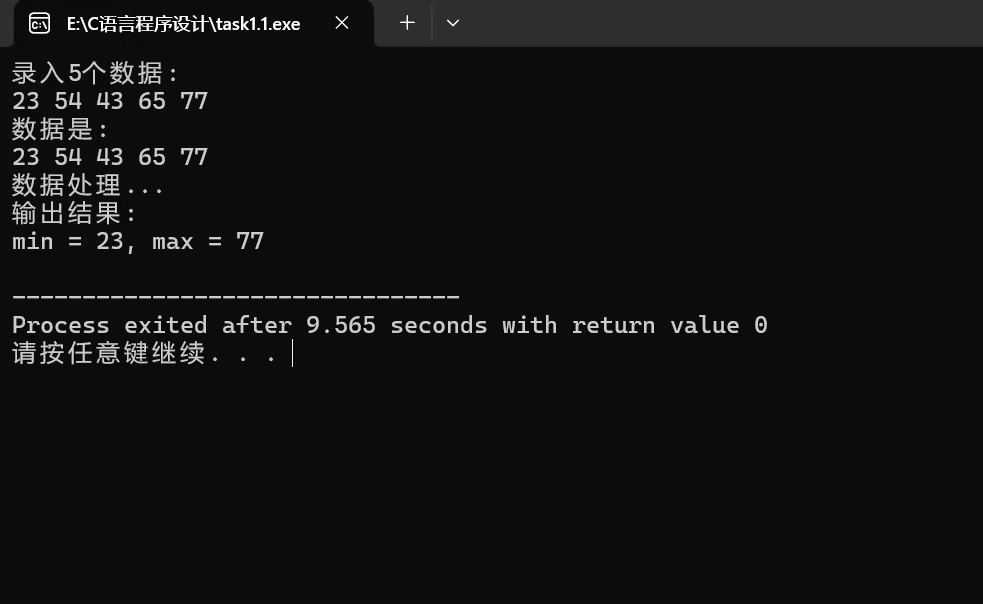
ans1:找到这五个数据中的最大值和最小值,并且返回
ans2:pmin和pmax分别指向主函数中的min和max变量的地址
实验任务1.2
代码
点击查看代码
#include <stdio.h>
#define N 5
void input(int x[], int n);
void output(int x[], int n);
int *find_max(int x[], int n);
int main() {
int a[N];
int *pmax;
printf("录入%d个数据:\n", N);
input(a, N);
printf("数据是: \n");
output(a, N);
printf("数据处理...\n");
pmax = find_max(a, N);
printf("输出结果:\n");
printf("max = %d\n", *pmax);
return 0;
}
void input(int x[], int n) {
int i;
for(i = 0; i < n; ++i)
scanf("%d", &x[i]);
}
void output(int x[], int n) {
int i;
for(i = 0; i < n; ++i)
printf("%d ", x[i]);
printf("\n");
}
int *find_max(int x[], int n) {
int max_index = 0;
int i;
for(i = 0; i < n; ++i)
if(x[i] > x[max_index])
max_index = i;
return &x[max_index];
}
截图
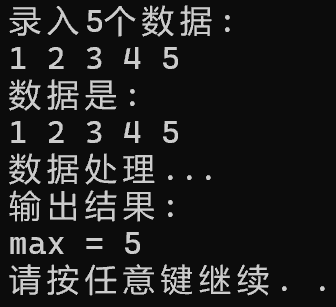
ans1:返回数组中最大元素的地址
ans2:可以,源代码和改写代码后的代码功能相同,都是通过遍历数组找到最大元素的地址并返回
实验任务2.1
代码
点击查看代码
#include <stdio.h>
#include <string.h>
#define N 80
int main() {
char s1[N] = "Learning makes me happy";
char s2[N] = "Learning makes me sleepy";
char tmp[N];
printf("sizeof(s1) vs. strlen(s1): \n");
printf("sizeof(s1) = %d\n", sizeof(s1));
printf("strlen(s1) = %d\n", strlen(s1));
printf("\nbefore swap: \n");
printf("s1: %s\n", s1);
printf("s2: %s\n", s2);
printf("\nswapping...\n");
strcpy(tmp, s1);
strcpy(s1, s2);
strcpy(s2, tmp);
printf("\nafter swap: \n");
printf("s1: %s\n", s1);
printf("s2: %s\n", s2);
return 0;
}
截图
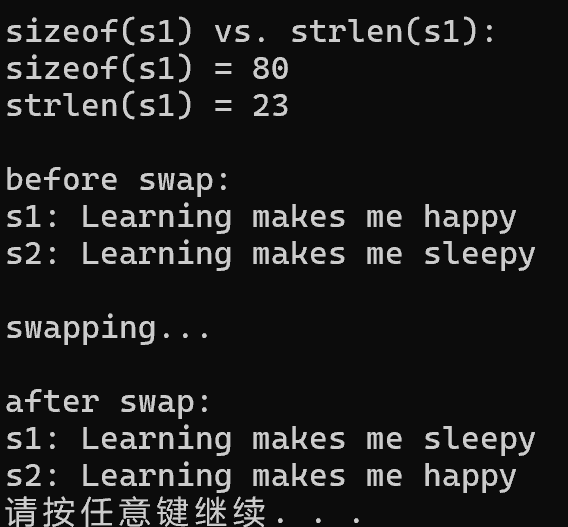
ans1:大小是80字节。计算的是数组s1占用的总内存大小。统计的是字符串s1的实际长度
ans2:不能,因为数组名s1是常量指针,不能被重新赋值
ans3:是的,line19-21执行后,字符数组s1和s2中的内容确实交换了
实验任务2.2
代码
点击查看代码
#include <stdio.h>
#include <string.h>
#define N 80
int main() {
char *s1 = "Learning makes me happy";
char *s2 = "Learning makes me sleepy";
char *tmp;
printf("sizeof(s1) vs. strlen(s1): \n");
printf("sizeof(s1) = %d\n", sizeof(s1));
printf("strlen(s1) = %d\n", strlen(s1));
printf("\nbefore swap: \n");
printf("s1: %s\n", s1);
printf("s2: %s\n", s2);
printf("\nswapping...\n");
tmp = s1;
s1 = s2;
s2 = tmp;
printf("\nafter swap: \n");
printf("s1: %s\n", s1);
printf("s2: %s\n", s2);
return 0;
}
截图
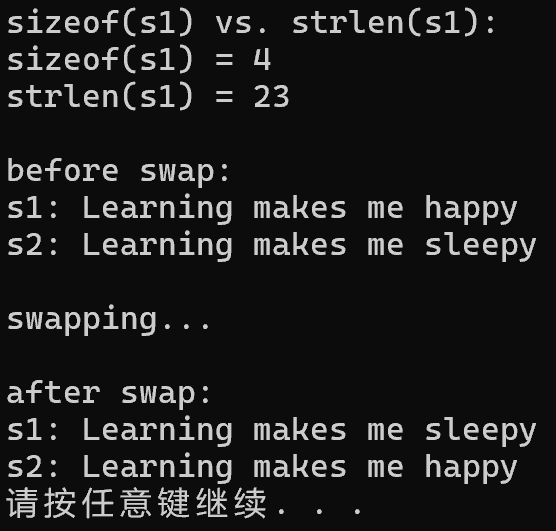
ans1:s1中存放的是字符串常量的地址。计算的是指针变量本身的大小。统计的是字符串的长度
ans2:可以。这里的s1是指针变量,可以被重新赋值指向不同的字符串常量,而task1.1中的s1是数组名,不能被重新赋值
ans3:交换的是指针变量的值,字符串常量在内存中的位置没有改变
task3
实验任务3
代码
点击查看代码
#include <stdio.h>
int main()
{
int x[2][4] = {{1, 9, 8, 4}, {2, 0, 4, 9}};
int i, j;
int *ptr1; // 指针变量,存放int类型数据的地址
int(*ptr2)[4]; // 指针变量,指向包含4个int元素的一维数组
printf("输出1: 使用数组名、下标直接访问二维数组元素\n");
for (i = 0; i < 2; ++i) {
for (j = 0; j < 4; ++j)
printf("%d ", x[i][j]);
printf("\n");
}
printf("\n输出2: 使用指针变量ptr1(指向元素)间接访问\n");
for (ptr1 = &x[0][0], i = 0; ptr1 < &x[0][0] + 8; ++ptr1, ++i) {
printf("%d ", *ptr1);
if ((i + 1) % 4 == 0)
printf("\n");
}
printf("\n输出3: 使用指针变量ptr2(指向一维数组)间接访问\n");
for (ptr2 = x; ptr2 < x + 2; ++ptr2) {
for (j = 0; j < 4; ++j)
printf("%d ", *(*ptr2 + j));
printf("\n");
}
return 0;
}
截图
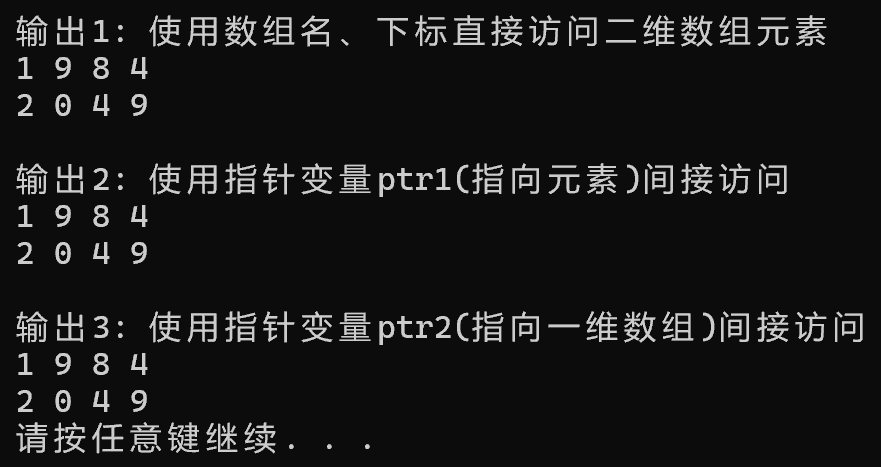
实验任务4
代码
点击查看代码
#include <stdio.h>
#define N 80
#include<stdlib.h>
void replace(char *str, char old_char, char new_char); // 函数声明
int main() {
char text[N] = "Programming is difficult or not, it is a question.";
printf("原始文本: \n");
printf("%s\n", text);
replace(text, 'i', '*'); // 函数调用 注意字符形参写法,单引号不能少
printf("处理后文本: \n");
printf("%s\n", text);
system("pause");
return 0;
}
// 函数定义
void replace(char *str, char old_char, char new_char) {
int i;
while(*str) {
if(*str == old_char)
*str = new_char;
str++;
}
}
截图

实验任务5
代码
点击查看代码
#include <stdio.h>
#define N 80
char *str_trunc(char *str, char x);
int main() {
char str[N];
char ch;
while(printf("输入字符串: "), gets(str) != NULL) {
printf("输入一个字符: ");
ch = getchar();
printf("截断处理...\n");
str_trunc(str, ch); // 函数调用
printf("截断处理后的字符串: %s\n\n", str);
getchar();
}
return 0;
}
// 函数str_trunc定义
// 功能: 对字符串作截断处理,把指定字符自第一次出现及其后的字符全部删除, 并返回字符串地址
// 待补足...
char *str_trunc(char *str, char x)
{
char *p = str;
while (*p != '\0') {
if (*p == x) {
*p = '\0';
break;
}
p++;
}
return str;
}
截图

实验任务6
代码
点击查看代码
#include <stdio.h>
#include <string.h>
#define N 5
#include<stdlib.h>
#include<ctype.h>
int check_id(char *str); // 函数声明
int main()
{
char *pid[N] = {"31010120000721656X",
"3301061996X0203301",
"53010220051126571",
"510104199211197977",
"53010220051126133Y"};
int i;
for (i = 0; i < N; ++i)
if (check_id(pid[i])) // 函数调用
printf("%s\tTrue\n", pid[i]);
else
printf("%s\tFalse\n", pid[i]);
system("pause");
return 0;
}
int check_id(char *str) {
int i;
int len = strlen(str);
if(len != 18) return 0;
for(i = 0;i < 17;i++){
if(!isdigit(str[i])) return 0;
}
if(!isdigit(str[17]) && str[17] != 'X') return 0;
return 1;
}
截图
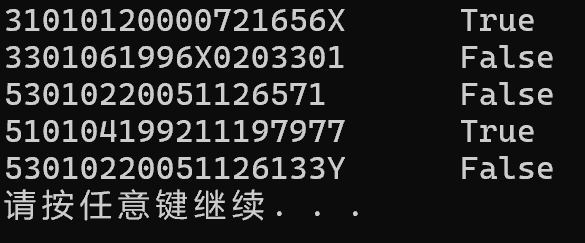
实验任务7
代码
点击查看代码
#include <stdio.h>
#define N 80
void encoder(char *str, int n); // 函数声明
void decoder(char *str, int n); // 函数声明
#include<stdlib.h>
int main() {
char words[N];
int n;
printf("输入英文文本: ");
gets(words);
printf("输入n: ");
scanf("%d", &n);
printf("编码后的英文文本: ");
encoder(words, n); // 函数调用
printf("%s\n", words);
printf("对编码后的英文文本解码: ");
decoder(words, n); // 函数调用
printf("%s\n", words);
system("pause");
return 0;
}
void encoder(char *str, int n) {
while (*str) {
if (*str >= 'a' && *str <= 'z') {
*str = 'a' + (*str - 'a' + n) % 26;
} else if (*str >= 'A' && *str <= 'Z') {
*str = 'A' + (*str - 'A' + n) % 26;
}
str++;
}
}
void decoder(char *str, int n) {
while (*str) {
if (*str >= 'a' && *str <= 'z') {
*str = 'a' + (*str - 'a' - n + 26) % 26;
} else if (*str >= 'A' && *str <= 'Z') {
*str = 'A' + (*str - 'A' - n + 26) % 26;
}
str++;
}
}
截图



实验任务8
代码
点击查看代码
#include <stdio.h>
#include <string.h>
#include<stdlib.h>
int main(int argc, char *argv[]) {
int i,j;
for (i = 1; i < argc; i++) {
for (j = i + 1; j < argc; j++) {
if (strcmp(argv[i], argv[j]) > 0) {
char *temp = argv[i];
argv[i] = argv[j];
argv[j] = temp;
}
}
}
for (i = 1; i < argc; i++) {
printf("hello, %s\n", argv[i]);
}
system("pause");
return 0;
}
截图
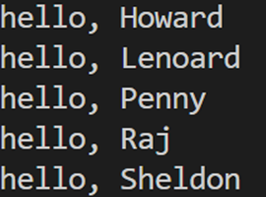




 浙公网安备 33010602011771号
浙公网安备 33010602011771号